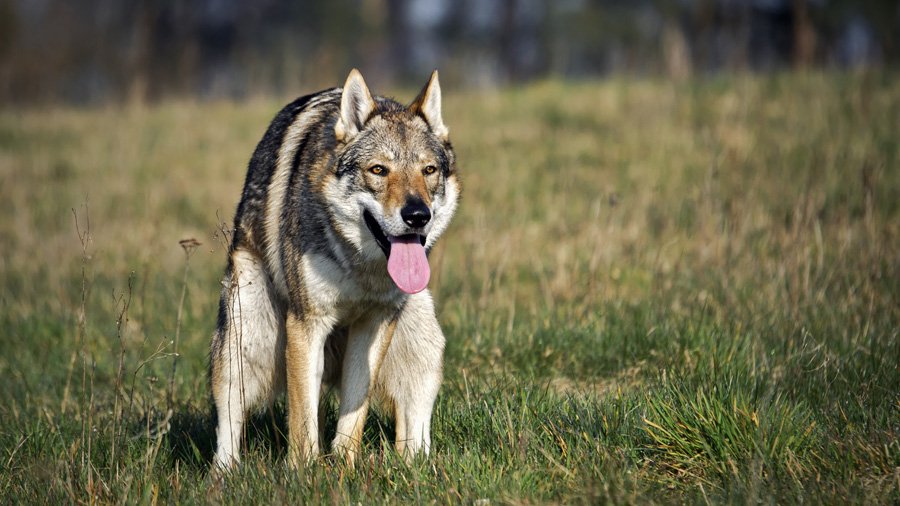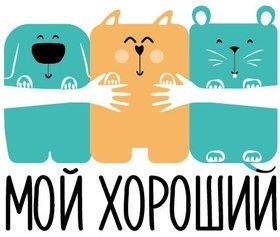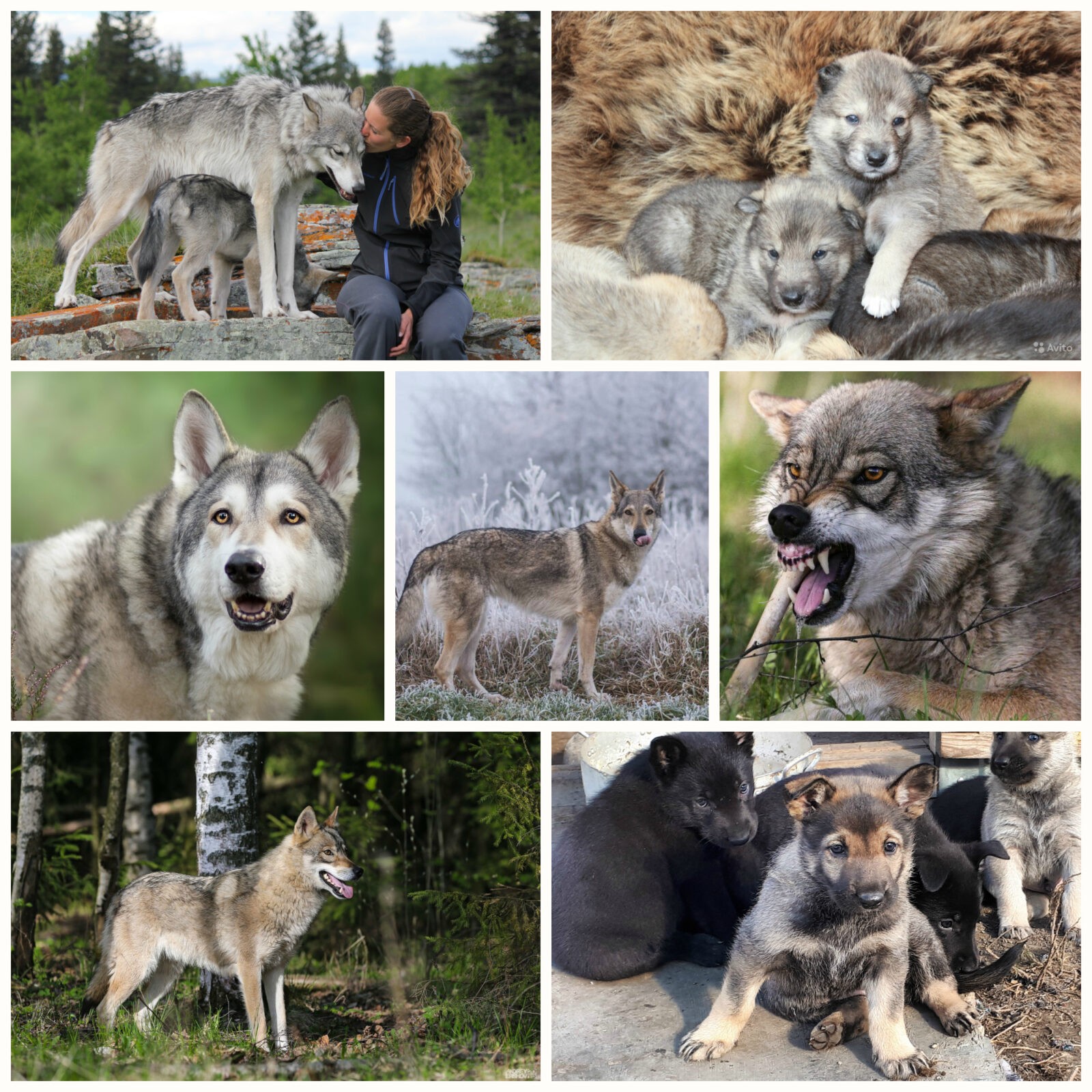
Brief description of the Volkosob breed
The appearance of a wolfhound is very similar to that of a wolf, the coat is thick, with an undercoat, the color varies from light to dark gray or brown, black. The growth of wolfdogs ranges from 60 to 70 cm, the weight of mestizos is 30-50 kg. These animals are distinguished by well-developed muscles, taut, high on their feet. The head of wolfdogs is decorated with erect ears of medium size, almond-shaped eyes of amber or light brown. An ignorant person can easily confuse a wolfdog with an ordinary wolf - they are so similar in appearance. Such a breed requires special training and the presence of a competent owner who is aware that he has bailed out a dog that combines the features of a predator and a domestic animal. A wolfdog, even in the 3rd or 4th generation, can have characteristic wolf features, be distrustful of a person and be somewhat aggressive. That is why this breed is most often used for military service. - hardy, cunning, with a keen sense of smell (it is believed that the scent of a wolfdog is 6 times greater than the scent of dogs of other breeds), weatherproof animals, trained and coached by experienced professionals. There are legends about the sharpness of the fangs of wolfhounds, which can, on occasion, become a deadly weapon. One of the distinguishing features that betrays the relationship of these animals with the wolf - they rarely give a voice, but on occasion they can howl.
basic information
| Breed name: | Volkosob |
| Country of origin: | Russia |
| The time of the birth of the breed: | 2000s |
| Type of: | companion dog |
| The weight: | 30 – 50 kg |
| Height (height at the withers): | 60 - 70 cm |
| Life Expectancy: | 10 – 12 years old |
|
ICF classification:
|
not recognized |
| Puppies price: | 100 – 250 $ |
| Most popular nicknames: | list of nicknames for the wolfdog |
Assessment of the characteristics of the Volkosob breed
| Adaptability
(a definition meaning how easily a dog can adapt to changes in life) |
🐶🐶🐶🐶 |
| Shedding level
(Level and frequency of hair loss in the animal) |
🐶🐶🐶 |
| Tenderness level
(The level and amount of tenderness and affection that the dog gives in return for attention to itself) |
🐶🐶🐶 |
| Exercise needs
(Dog's daytime activity level) |
🐶🐶🐶🐶 |
| Social need
(The required number of contacts of the dog with other animals, as well as people) |
🐶🐶🐶🐶🐶 |
| Apartment content
(A factor that determines the level of noise and other inconveniences that a dog can deliver to owners in relation to the size of the apartment to the size of the dog) |
🐶 |
| Grooming
(The number of bathing, brushing, and the number of professional grooming sessions required for the dog) |
🐶🐶 |
| Friendliness in an unfamiliar environment
(Features of the behavior of a dog in a society with strangers or in an unfamiliar environment) |
🐶🐶🐶🐶 |
| Tendency to bark
(Tendency to bark and its frequency and volume) |
🐶🐶🐶 |
| Health issues
(Potential health status of the dog) |
🐶🐶🐶🐶🐶 |
| Territoriality
(The dog's tendency to protect his home, yard, or even his owner's car) |
🐶🐶🐶🐶🐶 |
| Friendliness to cats
(The tendency towards tolerance for cats and decreased manifestation of hunting instincts) |
🐶🐶🐶 |
| Intelligence
(The ability of the dog to think and solve emerging difficulties (not to be confused with learning!) |
🐶🐶🐶🐶 |
| Education and training
(The level of difficulty in training the dog to perform certain actions) |
🐶🐶🐶🐶🐶 |
| Friendliness to children
(A factor that determines how friendly a dog is to children, whether he likes to play with them and tolerate some childish pranks) |
🐶🐶🐶🐶 |
| Game activity
(The concept is determined by its very name, and, as a rule, is found in almost all dogs) |
🐶🐶🐶🐶🐶 |
| Observation
(The ability of a dog to detect the presence of a stranger on its territory) |
🐶🐶🐶🐶🐶 |
| Friendliness to other dogs
(The tendency of the dog to find common language with his other relatives) |
🐶🐶🐶🐶 |
Volkosob photo:
The history of the origin of the Volkosob breed
Many facts are known when dogs interbred with wolves, after which unusual offspring appeared. The first mention of hybrids appeared at least 10,000 years ago, when the domestication of wolves supposedly took place. There is an opinion that some wolf individuals independently adjoined people, not being afraid of them and treating them kindly. Further mating of closely related animals could subsequently lead to the emergence of a new family of canines, their main task was to participate and help people during the hunt. Much later, a huge number of breeders took part in the breeding of dog and wolf mestizos. And most often all attempts to get a seasoned, brave, strong animal, combining the features of a domestic dog and a predatory wolf, ended in failure. This was explained by the fact that the cubs were too aggressive and sometimes cowardly in nature, unstable mentality, and practically did not lend themselves to training. In addition, the bred individuals had multiple developmental anomalies that did not allow them to become real hardy service or working dogs. Today, there are about a dozen officially unrecognized breeds that appeared by crossing dogs of various breeds and wolves.
If we consider wolfdogs as breeds, then the founders are dog handlers of the Perm Military Institute, who from the second half of the 90s of the 20th century began to study the behavior and habits of wolves. suitable for crossing with dogs there could only be those individuals who were tolerant towards humans. It is believed that among all predators of the wolf genus, no more than 5 % animals can be successfully crossed with dogs. The remaining 95 %s are extremely distrustful, aggressive, and unpredictable. It should be noted that in most cases, relations between a male wolf and a female dog are used to breed offspring. But Perm cynologists managed to get the first offspring from another union. In 2000, there was a mating of a she-wolf named Naida and a male German shepherd named Baron. Such a union became possible, since Naida was brought up by a hunter from childhood, who instilled in her those qualities that are inherent in a domestic animal, and not a wild one. The she-wolf, even having matured, remained positively disposed towards people. The man who raised Naida subsequently handed her over to the specialists of the Perm Military Institute, in whose nursery the future "father" of wolfdogs was kept - black dog Baron, obedient and adequate. In the first litter in 2000, 5 puppies were born. Of the 4 survivors, only one wolfdog subsequently showed good results while serving at customs and the border. The rest of the animals showed a pronounced sense of distrust in humans, fear of new trials, technology, and so on. In the blood of the first litter of wolfdogs, 50% content of wolf blood was noted.
In 2001, another mating between Naida and Baron took place, after which 5 puppies were born, and only one of them was distinguished by a friendly attitude towards people, succumbed to training, but had a very independent and dominant character. Subsequently, in 2003 Naida was bred with a male from the second litter, and the new puppies already had 75 % wolf blood. Surprisingly, the puppies of the third litter turned out to be much bolder than the previous ones, they perfectly coped with the tasks set, they were not shy of people, they easily carried out the commands. Wolfdogs differed from dogs in excellent health, great physical strength, and the most acute sense of smell.
Subsequently, Perm specialists bred several generations of wolfdogs. To date, the experiment to breed a hybrid at the Perm Military Institute is considered closed. However, there are nurseries in our country that breed wolfdogs. The cost of a puppy starts from 15,000 rubles and more, and depends on the percentage of wolf and dog blood, the nature and age of the animal. Most often, mestizos of a wolf and a German shepherd are acquired for service in law enforcement agencies.
The character of the wolfdog
Maintenance and care
Wolfdogs should be kept outdoors, it is desirable to have a large aviary and an insulated booth. Despite the excellent health of wolfdogs both in heat and in cold, the animal should be provided with housing that will not be in a draft and will provide shade in sunny weather, and during frosts it will protect from hypothermia. The territory of the site where the animal will live must certainly be fenced with a reliable and high fence.
There are no special requirements for the care of such a dog. - timely feeding, the presence of clean water. Hair care consists in periodic combing (especially in spring and autumn, that is, during molting). Bathing wolfdogs should be carried out no more than 2 times a year. The owner should pay attention to the general condition of the dog - cleanliness of the ears, health of the eyes, shade of the mucous membranes. Dogs of this breed should not be put on a chain, since the restriction of freedom is fraught with the appearance of aggression not only towards strangers, but also towards their own owner. It can be concluded that the main conditions for keeping a wolfdog are not at all in carrying out care manipulations (washing, cutting claws, combing), the main thing is - build the right relationship with the animal, achieve its early socialization, do everything possible so that the wolf habits in it are for the benefit of the person.
Training and education
Health and disease
Some interesting facts
- Many still from the school bench are familiar with Jack London's wonderful story "White Fang" about the difficult fate of a wolf cub with an admixture of dog blood named Kichi. The writer very vividly described the behavior of animals, spoke about the cruelty of a person, which not only did not break Kichi, but also taught him a lot, and most importantly - did not kill his faith in kindness. In the mid-40s, the work was filmed in the USSR, then several more films of European production were presented to the audience. Currently, wolfhounds are popular on the set of films, when the plot requires a scene with a wolf. Since predatory animals are quite unpredictable, trained and adapted to humans, wolfdogs perfectly replace them, and due to their external similarity, it is almost impossible to distinguish them from real wolves.
- The dog, born in the first litter of the she-wolf Naida, who was given the nickname Scarlet, served on the Daurian border (border with Mongolia and China). Male Grey, who appeared in the second litter, showed excellent work in the search for explosives and drugs while serving in a dog training center in the Sverdlovsk region. Other individuals born to Naida distinguished themselves during the war in Chechnya, performing the assigned combat missions, withstanding all the hardships of a difficult time. Naida herself passed away in the fall of 2014, having lived for 18 years. She gave us dogs of the wolfdog breed, about which there is undeservedly little talk, many articles have not been written about their exploits for the sake of the well-being of civilians, and no films have been made. But it is wolfdogs who protect the peace and borders of our Motherland.
Nurseries and breeders
We borrowed material from the wonderful site of our partners DOGCATFAN.COM about cats and dogs, the author dogcatfan

